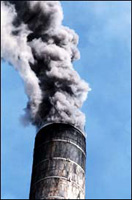
| B.C. First Cap-and Trade in Canada | 15 April 08 |
 British Columbia has announced a cap-and-trade system to reduce air pollution and greenhouse gas emissions. New legislation to cut GHGs by 33% by 2020 is part of B.C.'s plan. British Columbia has announced a cap-and-trade system to reduce air pollution and greenhouse gas emissions. New legislation to cut GHGs by 33% by 2020 is part of B.C.'s plan. Under the new Greenhouse Gas Reduction (Cap-and-trade) Act, the government will establish a cap on carbon dioxide emissions by issuing a limited number of tradable compliance units (emissions allowances) to emitters. Large emitters/polluters will participate in a government-monitored trading system that enables them to offset some emissions by trading or buying pollution credits. "It's a very important step forward in terms of building a continental carbon market," said Ian Carter, an Ottawa-based policy co-ordinator for the International Emissions Trading Association. "No one has actually done [what B.C. is doing] in North America. B.C. is definitely pioneering here." The act is expected to encourage innovative, low-cost solutions to reduce carbon pollution and will provide administrative penalties for violators. The cap-and-trade law allows B.C. to participate in the Western Climate Initiative, a partnership that involves Manitoba and seven U.S. states, including California. WCI members' population is now 63 million people with a GDP of $2.9 trillion (CAD). View April 4, 2008 CBC article View April 4, 2008 Canoe News article View April 4, 2008 Canada.com article View April 4, 2008 St. Catharine's Standard article View April 4, 2008 Globe and Mail article View April 4, 2008 National Post article View April 4, 2008 Truck News article View April 4, 2008 All Headline News article Visit Western Climate Initiative website View March 27, 2008 Pembina Institute Fact Sheet on Cap and Trade (PDF) Sources: CBC, Canoe, Canada.com, St Catharine's Standard, Globe and Mail, National Post, Truck News, All Headline News, WCI |
|
 Print version Print version |
Top |
